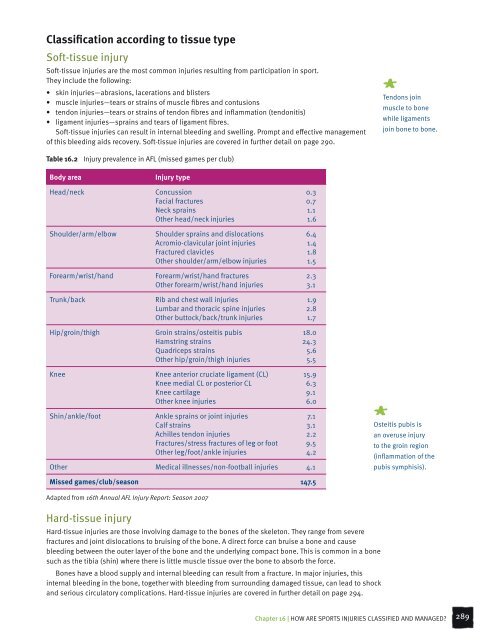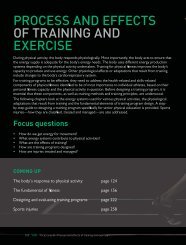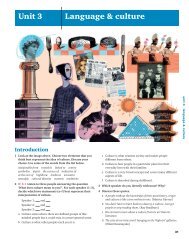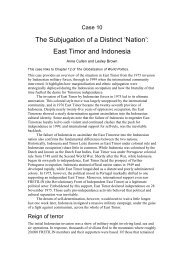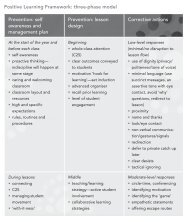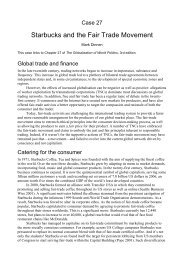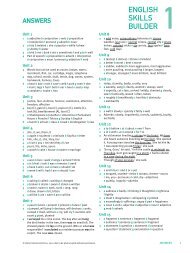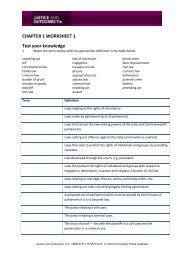Create successful ePaper yourself
Turn your PDF publications into a flip-book with our unique Google optimized e-Paper software.
Classification according <strong>to</strong> tissue type<br />
Soft-tissue injury<br />
Soft-tissue <strong>injuries</strong> are the most common <strong>injuries</strong> resulting from participation in sport.<br />
They include the following:<br />
• skin <strong>injuries</strong>—abrasions, lacerations and blisters<br />
• muscle <strong>injuries</strong>—tears or strains of muscle fibres and contusions<br />
• tendon <strong>injuries</strong>—tears or strains of tendon fibres and inflammation (tendonitis)<br />
• ligament <strong>injuries</strong>—sprains and tears of ligament fibres.<br />
Soft-tissue <strong>injuries</strong> can result in internal bleeding and swelling. Prompt and effective management<br />
of this bleeding aids recovery. Soft-tissue <strong>injuries</strong> are covered in further detail on page 290.<br />
Table 16.2 Injury prevalence in AFL (missed games per club)<br />
Body area Injury type<br />
Head/neck Concussion<br />
Facial fractures<br />
Neck sprains<br />
Other head/neck <strong>injuries</strong><br />
Shoulder/arm/elbow Shoulder sprains and dislocations<br />
Acromio-clavicular joint <strong>injuries</strong><br />
Fractured clavicles<br />
Other shoulder/arm/elbow <strong>injuries</strong><br />
Forearm/wrist/hand Forearm/wrist/hand fractures<br />
Other forearm/wrist/hand <strong>injuries</strong><br />
Trunk/back Rib and chest wall <strong>injuries</strong><br />
Lumbar and thoracic spine <strong>injuries</strong><br />
Other but<strong>to</strong>ck/back/trunk <strong>injuries</strong><br />
Hip/groin/thigh Groin strains/osteitis pubis<br />
Hamstring strains<br />
Quadriceps strains<br />
Other hip/groin/thigh <strong>injuries</strong><br />
Knee Knee anterior cruciate ligament (CL)<br />
Knee medial CL or posterior CL<br />
Knee cartilage<br />
Other knee <strong>injuries</strong><br />
Shin/ankle/foot Ankle sprains or joint <strong>injuries</strong><br />
Calf strains<br />
Achilles tendon <strong>injuries</strong><br />
Fractures/stress fractures of leg or foot<br />
Other leg/foot/ankle <strong>injuries</strong><br />
0.3<br />
0.7<br />
1.1<br />
1.6<br />
6.4<br />
1.4<br />
1.8<br />
1.5<br />
2.3<br />
3.1<br />
1.9<br />
2.8<br />
1.7<br />
18.0<br />
24.3<br />
5.6<br />
5.5<br />
Other Medical illnesses/non-football <strong>injuries</strong> 4.1<br />
Missed games/club/season 147.5<br />
Adapted from 16th Annual AFL Injury Report: Season 2007<br />
Hard-tissue injury<br />
Hard-tissue <strong>injuries</strong> are those involving damage <strong>to</strong> the bones of the skele<strong>to</strong>n. They range from severe<br />
fractures and joint dislocations <strong>to</strong> bruising of the bone. A direct force can bruise a bone and cause<br />
bleeding between the outer layer of the bone and the underlying compact bone. This is common in a bone<br />
such as the tibia (shin) where there is little muscle tissue over the bone <strong>to</strong> absorb the force.<br />
Bones have a blood supply and internal bleeding can result from a fracture. In major <strong>injuries</strong>, this<br />
internal bleeding in the bone, <strong>to</strong>gether with bleeding from surrounding damaged tissue, can lead <strong>to</strong> shock<br />
and serious circula<strong>to</strong>ry complications. Hard-tissue <strong>injuries</strong> are covered in further detail on page 294.<br />
15.9<br />
6.3<br />
9.1<br />
6.0<br />
7.1<br />
3.1<br />
2.2<br />
9.5<br />
4.2<br />
#<br />
Tendons join<br />
muscle <strong>to</strong> bone<br />
while ligaments<br />
join bone <strong>to</strong> bone.<br />
#<br />
Osteitis pubis is<br />
an overuse injury<br />
<strong>to</strong> the groin region<br />
(inflammation of the<br />
pubis symphisis).<br />
Chapter 16 | HOW ARE SPORTS INJURIES CLASSIFIED AND MANAGED?<br />
289


